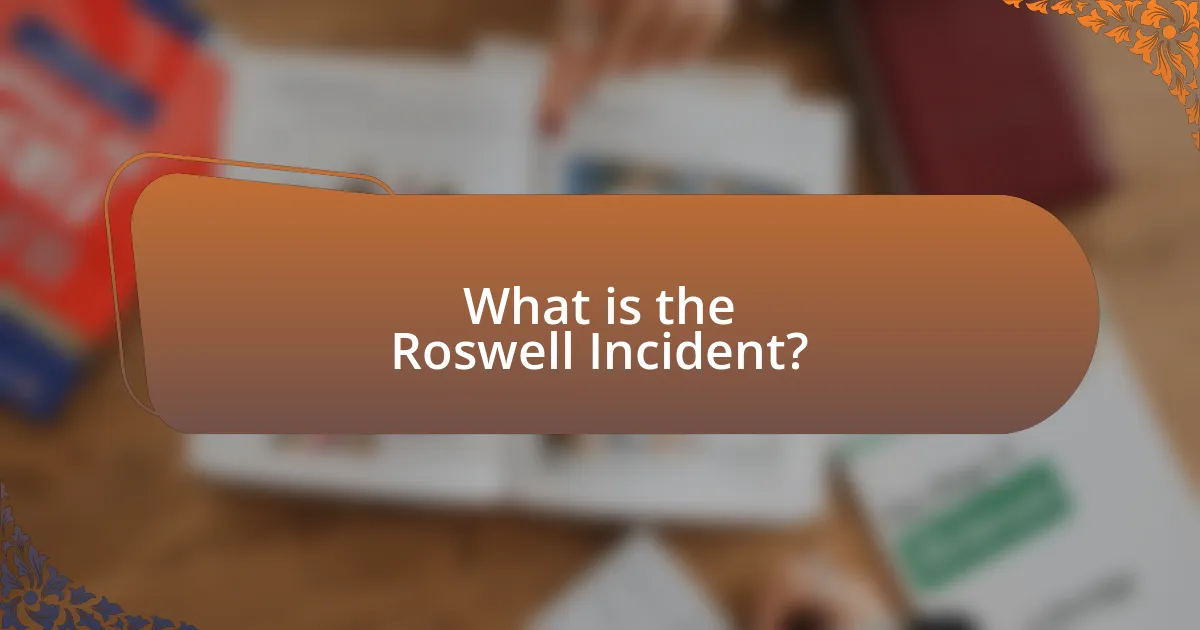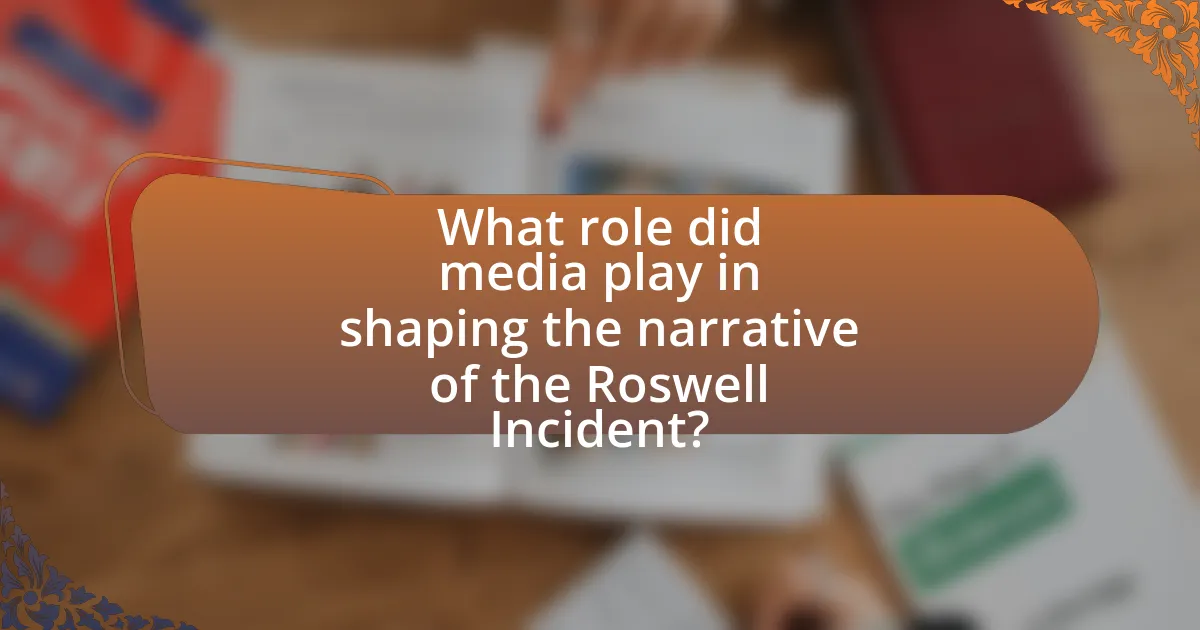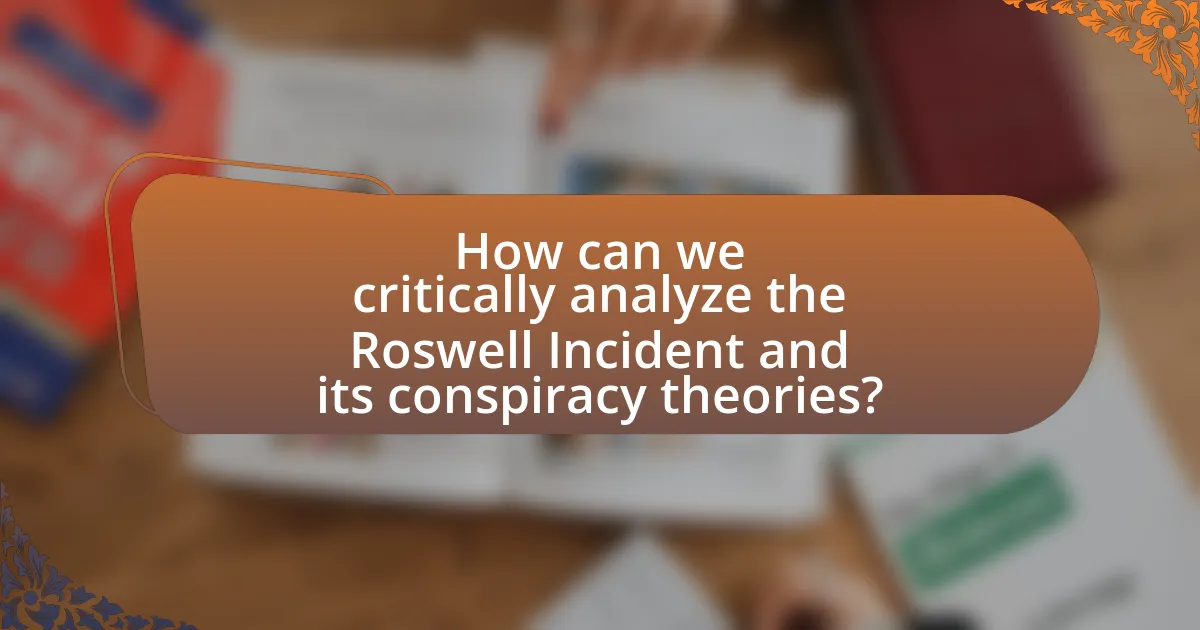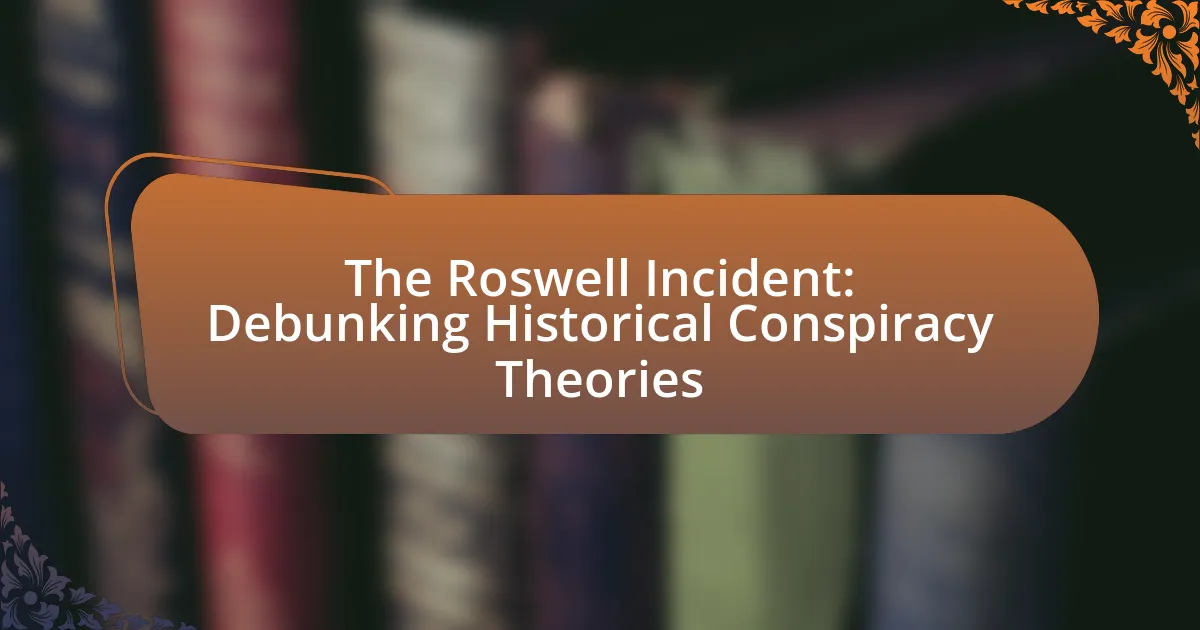The Roswell Incident refers to a significant event in July 1947 when an unidentified object crashed near Roswell, New Mexico, initially reported by the military as a “flying disc” before being retracted to a weather balloon explanation. This incident has become a cornerstone of UFO lore, sparking numerous conspiracy theories about extraterrestrial life and government cover-ups, largely due to the inconsistencies in military narratives and the role of sensationalist media. The article examines the historical context, initial reports, military responses, and the evolution of conspiracy theories surrounding the incident, while also addressing the evidence that debunks these theories and the implications for public trust in government. It highlights the importance of critical analysis and skepticism in understanding the Roswell Incident and its lasting impact on contemporary UFO discourse.

What is the Roswell Incident?
The Roswell Incident refers to an event in July 1947 when an unidentified object crashed near Roswell, New Mexico. Initially reported by the military as a “flying disc,” the U.S. Army later retracted this statement, claiming it was a weather balloon. This incident has since become a focal point for conspiracy theories regarding extraterrestrial life and government cover-ups, fueled by the lack of transparency and the subsequent military explanations. The U.S. Air Force later published reports, such as “The Roswell Report: Fact vs. Fiction in the New Mexico Desert,” which concluded that the debris was part of a classified program called Project Mogul, aimed at detecting Soviet nuclear tests.
How did the Roswell Incident become a significant event in UFO history?
The Roswell Incident became a significant event in UFO history due to the recovery of an unidentified object by the U.S. military in July 1947, which was initially reported as a “flying disc.” This incident sparked widespread public interest and speculation about extraterrestrial life. The subsequent military retraction, stating it was merely a weather balloon, fueled conspiracy theories and distrust in government narratives. Over the decades, the Roswell Incident has been referenced in numerous books, documentaries, and popular culture, solidifying its status as a cornerstone of UFO lore and contributing to ongoing debates about government secrecy and the existence of alien life.
What were the initial reports surrounding the Roswell Incident?
The initial reports surrounding the Roswell Incident in July 1947 claimed that a “flying disc” had crashed on a ranch near Roswell, New Mexico. The U.S. Army Air Forces initially issued a press release stating they had recovered a “flying saucer,” which was later retracted, stating it was a weather balloon. This shift in narrative fueled speculation and conspiracy theories about extraterrestrial life and government cover-ups. The initial excitement was driven by local media coverage and public interest, leading to ongoing debates about the true nature of the incident.
How did the U.S. military respond to the incident?
The U.S. military responded to the Roswell incident by initially announcing that they had recovered a “flying disc” but later retracted that statement, claiming it was a weather balloon. This shift in narrative occurred shortly after the initial press release on July 8, 1947, which generated significant public interest and speculation. The military’s subsequent explanation was part of a broader effort to manage the narrative surrounding the incident and mitigate public concern over potential extraterrestrial activity.
Why do conspiracy theories persist about the Roswell Incident?
Conspiracy theories persist about the Roswell Incident primarily due to a combination of government secrecy, public fascination with extraterrestrial life, and the initial miscommunication surrounding the event. The U.S. military’s initial announcement in July 1947 that a “flying disc” had been recovered, followed by a retraction stating it was a weather balloon, fueled speculation and distrust. This inconsistency led to widespread belief that the government was concealing the truth about UFOs. Additionally, the cultural context of the late 1940s, marked by the onset of the Cold War and a growing interest in science fiction, contributed to the allure of conspiracy theories. The ongoing media coverage and popular culture references have further entrenched these theories in public consciousness, making them resilient despite lack of credible evidence.
What are the most common conspiracy theories related to the Roswell Incident?
The most common conspiracy theories related to the Roswell Incident include the belief that the U.S. government recovered an extraterrestrial spacecraft and its occupants in 1947. Proponents of this theory argue that the military’s initial announcement of a “flying disc” recovery was quickly retracted in favor of a weather balloon explanation, suggesting a cover-up. Additionally, some theories claim that the government conducted secret experiments on alien bodies at military facilities, particularly Area 51. These theories are supported by testimonies from alleged witnesses and former military personnel who assert they saw unusual materials or beings. The enduring nature of these conspiracy theories is fueled by a combination of government secrecy, public fascination with UFOs, and the lack of definitive evidence to disprove them.
How have these theories evolved over time?
Theories surrounding the Roswell Incident have evolved significantly from the initial reports in 1947 to contemporary interpretations. Initially, the U.S. military claimed that a “flying disc” had been recovered, which was later retracted to state it was a weather balloon, leading to widespread speculation about extraterrestrial involvement. Over the decades, various conspiracy theories emerged, fueled by government secrecy and public fascination with UFOs, particularly during the 1970s and 1980s when interest in alien life surged.
In the 1990s, the U.S. Air Force released reports clarifying that the debris was part of a top-secret project called Project Mogul, which aimed to detect Soviet nuclear tests. This revelation prompted a shift in the narrative, as some conspiracy theorists began to incorporate elements of government cover-ups into their theories. More recently, the advent of the internet has allowed for rapid dissemination of information and misinformation, leading to a proliferation of theories that blend historical facts with speculative narratives.
The evolution of these theories reflects broader societal trends, including changing attitudes toward government transparency and the increasing popularity of science fiction, which has influenced public perception of the Roswell Incident as a cultural phenomenon rather than just a historical event.
What evidence supports or debunks the conspiracy theories?
Evidence debunking conspiracy theories surrounding the Roswell Incident includes official military reports and eyewitness testimonies. The U.S. Air Force released a report in 1994 titled “The Roswell Report: Fact vs. Fiction in the New Mexico Desert,” which concluded that the recovered debris was from a top-secret balloon project known as Project Mogul, designed to detect Soviet nuclear tests. Additionally, numerous eyewitness accounts have been scrutinized and found inconsistent, with many witnesses later recanting their claims or admitting to exaggeration. The combination of these official documents and the analysis of eyewitness reliability provides a strong basis for debunking the conspiracy theories associated with the Roswell Incident.
What official documents have been released regarding the Roswell Incident?
The official documents released regarding the Roswell Incident include the U.S. Army Air Forces’ press release from July 8, 1947, which initially described the recovery of a “flying disc,” later retracted and clarified as a weather balloon. Additionally, the U.S. Air Force published the “Roswell Report: Fact vs. Fiction in the New Mexico Desert” in 1994, which concluded that the debris found was part of Project Mogul, a classified program involving high-altitude balloons designed to detect Soviet nuclear tests. These documents provide insight into the military’s response and the subsequent explanations surrounding the incident.
How do eyewitness accounts compare to official narratives?
Eyewitness accounts often differ significantly from official narratives, particularly in cases like the Roswell Incident. Eyewitnesses reported seeing unusual debris and military activity, suggesting a crash of an unidentified object, while official narratives initially described the event as a “flying disc” and later retracted it to a weather balloon. This discrepancy highlights the potential for misinterpretation or manipulation of information, as seen in the U.S. Air Force’s 1994 report, which claimed the debris was from a Project Mogul balloon, contradicting earlier eyewitness testimonies. Such differences raise questions about the reliability of both eyewitness accounts and official explanations in historical events.

What role did media play in shaping the narrative of the Roswell Incident?
Media played a crucial role in shaping the narrative of the Roswell Incident by amplifying initial reports and fueling public speculation. In July 1947, the Roswell Army Air Field issued a press release claiming to have recovered a “flying disc,” which was later retracted, stating it was a weather balloon. This initial excitement was widely covered by newspapers, including the Roswell Daily Record, which featured sensational headlines that captured public interest. The media’s portrayal transformed the incident from a military mishap into a cornerstone of UFO lore, leading to decades of conspiracy theories. The extensive coverage and sensationalism by various outlets established a narrative that persisted in popular culture, influencing subsequent investigations and public perception of extraterrestrial life.
How did newspapers report on the Roswell Incident in 1947?
Newspapers reported on the Roswell Incident in 1947 by initially describing the recovery of a “flying disc” by the military, which was later retracted and clarified as a weather balloon. The Roswell Daily Record published an article on July 8, 1947, featuring the headline “RAAF Captures Flying Saucer on Ranch in Roswell Region,” which fueled public interest and speculation about extraterrestrial life. However, the U.S. Army Air Forces quickly issued a statement claiming the recovered object was a weather balloon, leading to confusion and conspiracy theories that persisted for decades. This shift in narrative from an alien spacecraft to a mundane explanation contributed to the incident’s lasting impact on UFO lore and public perception.
What impact did sensationalist journalism have on public perception?
Sensationalist journalism significantly shaped public perception by amplifying fear and curiosity surrounding events like the Roswell Incident. This type of journalism often prioritized dramatic narratives over factual reporting, leading to widespread misconceptions about extraterrestrial encounters. For instance, the initial reports of a “flying disc” in 1947 were sensationalized, resulting in a media frenzy that fueled conspiracy theories and public fascination with UFOs. The impact was profound, as it created a lasting cultural narrative that blurred the lines between reality and fiction, influencing how the public interprets similar events even decades later.
How have documentaries and films influenced the Roswell narrative?
Documentaries and films have significantly shaped the Roswell narrative by popularizing and dramatizing the events surrounding the 1947 incident. Notable productions, such as the 1995 film “Roswell” and the 2005 documentary “Out of the Blue,” have introduced fictionalized elements and speculative theories that have become ingrained in public consciousness. These visual media portrayals often emphasize government cover-ups and extraterrestrial encounters, reinforcing conspiracy theories rather than presenting a balanced historical account. The impact is evident in the increased public interest and belief in UFO phenomena, as surveys indicate that a substantial portion of the population views the Roswell incident as evidence of alien life, influenced largely by these cinematic interpretations.
What are the implications of the Roswell Incident on modern UFO discourse?
The Roswell Incident significantly shaped modern UFO discourse by establishing a framework for public fascination and skepticism regarding extraterrestrial life. The 1947 event, initially reported as the recovery of a “flying disc,” later transformed into a narrative of government cover-up and conspiracy, influencing how UFO sightings and encounters are perceived today. This incident catalyzed the emergence of various UFO organizations and research groups, such as the Mutual UFO Network (MUFON), which seek to investigate and document sightings, thereby legitimizing the discourse surrounding unidentified aerial phenomena. Furthermore, the Roswell Incident has become a cultural touchstone, referenced in media and popular culture, which perpetuates interest and speculation about UFOs, ultimately shaping public opinion and government policy on the subject.
How has the Roswell Incident influenced contemporary UFO sightings and reports?
The Roswell Incident has significantly influenced contemporary UFO sightings and reports by shaping public perception and fueling ongoing interest in extraterrestrial phenomena. The 1947 event, initially reported as the recovery of a “flying disc,” was later reclassified by the U.S. military as a weather balloon, leading to widespread speculation and conspiracy theories about government cover-ups. This incident established a cultural framework that legitimized UFO sightings as credible phenomena, prompting individuals to report their experiences more frequently. According to a 2021 survey by the National UFO Reporting Center, there has been a notable increase in reported sightings, with over 7,000 cases documented in the United States alone, reflecting the lasting impact of the Roswell narrative on public engagement with UFOs.
What lessons can be learned from the Roswell Incident regarding public trust in government?
The Roswell Incident illustrates that government transparency is crucial for maintaining public trust. The initial military announcement in 1947 claimed the recovery of a “flying disc,” which was later retracted, stating it was merely a weather balloon. This inconsistency fueled conspiracy theories and skepticism towards government communications. Historical analysis shows that the lack of clear, consistent information from authorities can lead to public distrust, as seen in subsequent decades where similar incidents were met with suspicion. The Roswell case serves as a reminder that open communication and accountability are essential for fostering trust between the government and its citizens.

How can we critically analyze the Roswell Incident and its conspiracy theories?
To critically analyze the Roswell Incident and its conspiracy theories, one must examine the historical context, the evidence presented, and the motivations behind the theories. The Roswell Incident, which occurred in July 1947, involved the recovery of debris from a crashed object near Roswell, New Mexico, initially reported by the military as a “flying disc” but later reclassified as a weather balloon. This shift in narrative has fueled conspiracy theories suggesting a government cover-up of extraterrestrial contact.
Analyzing the incident requires scrutinizing primary sources, such as military reports and eyewitness testimonies, while also considering the socio-political climate of the time, including the onset of the Cold War and public fascination with UFOs. For instance, the U.S. Air Force’s 1994 report, “The Roswell Report: Fact vs. Fiction in the New Mexico Desert,” concluded that the debris was part of Project Mogul, a classified program involving high-altitude balloons designed to detect Soviet nuclear tests. This report provides concrete evidence that counters many conspiracy theories.
Furthermore, understanding the psychological and cultural factors that contribute to the persistence of these theories is essential. Theories often thrive in environments of distrust towards government institutions, as seen in the aftermath of events like Watergate and the Vietnam War. By critically evaluating the available evidence and the context in which these theories emerged, one can form a more informed perspective on the Roswell Incident and its associated conspiracy theories.
What methodologies can be used to evaluate the credibility of sources related to the Roswell Incident?
To evaluate the credibility of sources related to the Roswell Incident, researchers can employ methodologies such as source triangulation, historical context analysis, and critical discourse analysis. Source triangulation involves cross-referencing multiple accounts and documents to identify consistencies and discrepancies, which helps establish reliability. Historical context analysis examines the socio-political environment during the time of the incident, allowing for a better understanding of motivations behind various narratives. Critical discourse analysis focuses on the language and framing used in the sources, revealing biases and underlying agendas. These methodologies collectively enhance the assessment of credibility by providing a comprehensive framework for analysis.
How can critical thinking help in assessing conspiracy theories?
Critical thinking aids in assessing conspiracy theories by enabling individuals to evaluate evidence, identify logical fallacies, and differentiate between credible sources and misinformation. This analytical approach encourages questioning assumptions and examining the validity of claims, which is crucial in the context of conspiracy theories like the Roswell Incident. For instance, critical thinkers can scrutinize the lack of empirical evidence supporting the idea of an alien spacecraft crash, as well as the numerous scientific explanations provided by experts, such as weather balloons. By applying critical thinking, individuals can arrive at more informed conclusions, reducing the likelihood of being misled by unfounded theories.
What role does skepticism play in understanding historical events like the Roswell Incident?
Skepticism plays a crucial role in understanding historical events like the Roswell Incident by promoting critical analysis of claims and evidence. This approach encourages individuals to question the validity of eyewitness accounts, government statements, and conspiracy theories surrounding the incident, which occurred in 1947 when an unidentified object crashed near Roswell, New Mexico. For instance, the U.S. military initially described the object as a “flying disc,” but later retracted this statement, claiming it was a weather balloon. This inconsistency has fueled skepticism and led to various interpretations of the event. By applying skepticism, researchers can differentiate between substantiated facts and speculative narratives, ultimately fostering a more accurate historical understanding of the Roswell Incident.
What practical steps can individuals take to engage with the Roswell Incident critically?
Individuals can engage with the Roswell Incident critically by researching credible sources, analyzing primary documents, and evaluating expert opinions. Researching credible sources involves examining books, articles, and documentaries that provide factual information about the incident, such as “The Roswell Report: Fact vs. Fiction in the New Mexico Desert” published by the U.S. Air Force in 1994, which details the military’s investigation and findings. Analyzing primary documents, including military memos and eyewitness accounts, allows individuals to assess the authenticity and context of the claims made. Evaluating expert opinions from historians and scientists who specialize in UFO phenomena can provide a balanced perspective on the incident, helping to distinguish between fact and speculation. These steps enable individuals to form a well-rounded understanding of the Roswell Incident and its implications in the context of historical conspiracy theories.
How can one differentiate between credible information and misinformation about the Roswell Incident?
To differentiate between credible information and misinformation about the Roswell Incident, one should evaluate the sources of the information. Credible information typically comes from established historians, government documents, and peer-reviewed research, while misinformation often originates from unverified websites, conspiracy theorists, or sensationalist media. For instance, the U.S. military’s official reports and the 1994 Roswell Report, which concluded that the recovered materials were from a top-secret balloon project, provide credible insights. In contrast, claims of alien spacecraft without substantiated evidence fall into the category of misinformation. Thus, assessing the reliability of the source and the evidence presented is crucial in distinguishing fact from fiction regarding the Roswell Incident.
What resources are available for further research on the Roswell Incident and related conspiracy theories?
For further research on the Roswell Incident and related conspiracy theories, key resources include the book “The Roswell Incident” by Charles Berlitz and William L. Moore, which provides an in-depth analysis of the events and theories surrounding the incident. Additionally, the National Archives and Records Administration offers declassified documents related to the U.S. military’s response to the incident, which can be accessed online. The website of the Mutual UFO Network (MUFON) also contains a wealth of reports and investigations into UFO sightings, including the Roswell case. Furthermore, academic journals such as “The Journal of Popular Culture” often publish articles examining the cultural impact of the Roswell Incident and its conspiracy theories, providing scholarly perspectives on the topic.
